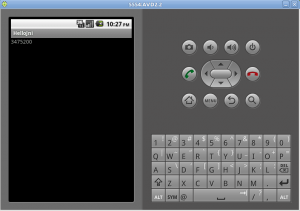在继上篇在32位的Ubuntu 11.04中为Android NDK r6编译FFmpeg最新版0.8.1后,本人来给大家展示一下如何在Android中使用编译好的FFmpeg库。
整体调用逻辑为:
1 编译完ffmpeg库
2 使用jni方式撰写c代码,其中需要包含相应的ffmpeg的头文件
3 撰写相应的Android.mk文件,里面指定需要编译的c代码以及需要链接的动态库
4 执行ndk-build生成相应的jni库
5 创建andorid java程序,代码中loadLibrary相应ffmpeg库以及刚才生成的jni库
6 静态方法声明native函数,这些函数在jni写的c语言中都已经实现过
下面为步骤:
1 将在32位的Ubuntu 11.04中为Android NDK r6编译FFmpeg最新版0.8.1文中编译得到的libffmpeg.so文件拷贝到/root/develop/android-ndk-r6/platforms/android-8/arch-arm/usr/lib目录,如果使用的是Android2.3的话,还需有拷贝到/root/develop/android-ndk-r6/platforms/android-9/arch-arm/usr/lib目录。
2 进入Android NDK r6的samples目录,我们基于最简单的hello-jni来修改。由于我们在调用ffmpeg库方法时候,需要使用到他的头文件。这里我们将之前编译libffmpeg.so文件的所有代码拷贝到/root/develop/android-ndk-r6/samples/目录,并改目录名称为ffmpeg
3 修改hello-jni.c文件
/*
* Copyright (C) 2009 The Android Open Source Project
*
* Licensed under the Apache License, Version 2.0 (the "License");
* you may not use this file except in compliance with the License.
* You may obtain a copy of the License at
*
* http://www.apache.org/licenses/LICENSE-2.0
*
* Unless required by applicable law or agreed to in writing, software
* distributed under the License is distributed on an "AS IS" BASIS,
* WITHOUT WARRANTIES OR CONDITIONS OF ANY KIND, either express or implied.
* See the License for the specific language governing permissions and
* limitations under the License.
*
*/
#include <string.h>
#include <stdio.h>
#include <android/log.h>
#include <stdlib.h>
#include <jni.h>
//注意这里,需要在当前目录包含的时候能够找到libavcodec/avcodec.h文件
#include <ffmpeg/libavcodec/avcodec.h>
/* This is a trivial JNI example where we use a native method
* to return a new VM String. See the corresponding Java source
* file located at:
*
* apps/samples/hello-jni/project/src/com/example/HelloJni/HelloJni.java
*/
//这里的命名注意,相当于com.example.hellojni的HelloJni文件中的stringFromJNI函数
jstring
Java_com_example_hellojni_HelloJni_stringFromJNI( JNIEnv* env,
jobject thiz )
{
char str[25];
sprintf(str, "%d", avcodec_version());
return (*env)->NewStringUTF(env, str);
}
4 修改Android.mk文件
LOCAL_PATHincludePATH_TO_FFMPEG_SOURCE:=$(LOCAL_PATH)/ffmpegLOCAL_C_INCLUDESLOCAL_LDLIBSLOCAL_MODULE LOCAL_SRC_FILESinclude |
注意LOCAL_LDLIBS := -lffmpeg是编译添加动态链接库文件。
5 进入命令行,在当前目录执行ndk-build
6 这时候会在/root/develop/android-ndk-r6/samples/hello-jni/libs/armeabi目录生成一个libhello-jni.so的动态链接库
7 为了后面的java程序能够loadLibrary,需要将之前生成的libffmpeg.so文件也拷贝到这个目录
8 修改HelloJni.java文件
package com.example.hellojni;
import android.app.Activity;
import android.widget.TextView;
import android.os.Bundle;
public class HelloJni extends Activity
{
@Override
public void onCreate(Bundle savedInstanceState)
{
super.onCreate(savedInstanceState);
TextView tv = new TextView(this);
tv.setText( "1111" );
//System.out.println();
setContentView(tv);
tv.setText(String.valueOf(stringFromJNI()));
}
public native String stringFromJNI();
static {
System.loadLibrary("ffmpeg");
System.loadLibrary("hello-jni");
}
}
执行后将看到如下图片:

本文源代码下载:
hello-jni
对应的编译完的libffmpeg.so文件下载
libffmpeg.so
ffmpeg文件夹比较大,这里不发了。可以从上篇文章找到。
对tq09931兄的文章表示感谢。
http://tq09931.iteye.com/blog/1011895
http://code.google.com/p/aacplayer-android/
http://www.roman10.net/?p=394
https://github.com/halfninja/android-ffmpeg-x264
https://github.com/mconf/ffmpeg
https://github.com/havlenapetr/FFMpeg
主参考
http://tq09931.iteye.com/blog/1011895
https://github.com/havlenapetr/FFMpeg
https://github.com/churnlabs/android-ffmpeg-sample